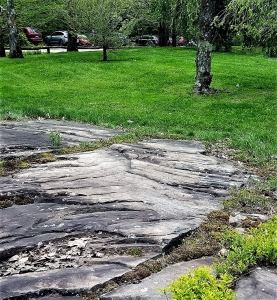Frozen in time
The Catskill Geologists; The Mountain Eagle; Nov. 30, 2023
Robert and Johanna Titus
Frozen in time is a common enough phrase. It usually refers to people or cultures who have not kept up with changes. Time goes by and changes come along, and those people and those cultures stay the same, stuck in the same old rut. Being frozen in time has a bit of a negative connotation. It happens when we just can’t change with time-or perhaps we don’t want to.

That time-worn old phrase leaped into our minds recently when we were up at the Mountain Top Arboretum. To geologists the notion of being frozen in time has a very different, even a professional meaning. We had been wandering the grounds at the Arboretum when we encountered an outcrop of typical Devonian aged Catskill sandstone. Are you familiar with the Arboretum? We are talking about the southeast corner of what is called the West Meadow. Usually seeing such rock is pretty routine and hardly very exciting, but this was different.
Take a look at our photo. Notice that the strata on the right dip to the right while those on the left dip in the opposite direction. What’s going on here? Well, we were looking at clues and were able to conjure up images of the distant past, a past that had given birth to our sandstone. These left- and right-leaning strata are said to be cross-bedded, actually the technical term is trough cross-bedded. That happens in modern river channels. On the deep, outer side of a wandering stream, the currents flow their fastest. When there are heavy rains, then the stream speeds up some more. It becomes erosional and scours out small channels, troughs, in the channel sands. At the end of the flood those currents slow down. That’s when the stream loses its ability to carry sediment, most of it being sand, and a depositional event follows. Sand fills in the troughs and is stratified in a fashion that is parallel to those scours – sometimes left leaning, sometimes right.
You wait a few million years, and all this hardens into stratified sandstone. Then you wait a few hundred million years more and that sandstone is exposed by the slow and steady processes of erosion. Well, that sums up what happened at the Arboretum and that is how we saw it. But then we got just a little philosophical. We began to ponder what we were looking at.
We were looking into the distant past. We were looking at the floor of a stream that had once flowed by here, across the top of something called the Catskill Delta. And we were looking at a moment in time. This was, essentially, an instant in time. All that sediment had been deposited right there and right at that moment. If any of those sand grains had a mind of its own, then it would have thought that there was no reason why another flood should not come along, sweep it up and carry it off to the nearest ocean.
And that is, in fact, what usually happens. Almost all grains of sediment are destined to enter an ocean and become part of the sediment there. Go to the Jersey shore and pick up a single grain of sand on the beach. There is a very good chance that your sand grain came from the Catskills and had traveled down the Hudson.
But not with our sand grains at the Mountain Top. They had become “frozen in time.” Their river channel deposits had come to be buried by more sediments – and then even more – thousands of feet more. All of this had hardened into the sedimentary rocks of the Catskills. Our mountains are an ancient delta deposit – frozen in time.
Contact the authors at randjtitus@prodigy.net. Join their facebook page “The Catskill Geologist.” Read their blogs at “thecatskillgeologist.com.”





